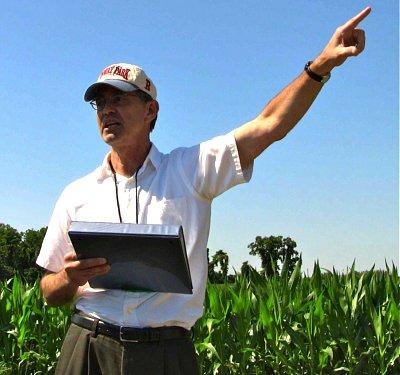Anyone who has ever taken a ranger- or historian-led battlefield tour understands the powerful insight provided by actually walking the ground where armies collided. But that experience pales in comparison to the opportunity afforded to Civil War Trust members at the annual meeting in early June 2012 in Richmond, Virginia.
I attended an eye-opening guided tour of the Gaines’ Mill battlefield and there was inspiring interpretation of the battle. But Trust members were in for a rare treat as they toured a 285-acre private parcel that the organization is raising funds to buy.
At a cost of $3.2 million, this tract will quadruple the Gaines’ Mill unit of Richmond National Battlefield Park where the Watt House still sits overlooking Boatswain’s Creek. Currently, only $150,000 of that sum still needs to be raised to successfully preserve this battlefield acreage by the deadline of September 4th. Time is tight. You could help make the difference.
Seeing the Bigger Picture
Imagine not just touring a postage-stamp of preserved terrain at Gaines’ Mill battlefield, but hiking extensive private lands that engulf the National Park Service property. Astoundingly—open and tree bordered agricultural land still surrounds the Gaines’ Mill site. A ramble over these fields—where vistas roll away across great distances and dirt roads snake as they did 150 years ago—presents an unparalleled opportunity to appreciate the entire battlefield (see the Trust's map, one of many free, excellent Civil War battlefields they offer).
The National Park Service preserves a mere 67 acres of a 3,000-acre arena where Robert E. Lee won his first victory after taking command by mounting the largest Confederate charge of the war.
Standing in a corn field while experts describe the battle raging around you—complete with what’s hidden beyond the rise you can’t see over—is a game-changing, inspiring invitation to preservation. With no cannons or interpretive signs—just chest high corn all around—it hits hard that our country’s history was nourished with blood that soaked into these very fields.
Trust president Jim Lighthizer’s fund-raising appeal for this land quotes an Alabama solider’s memoir that the dead “lay in heaps” on this farmland. He calls the Gaines’ Mill acreage “supremely important, blood-soaked, must-have hallowed ground.” The 1993 Congressional report on disappearing battlefields called it one of the top 11 most threatened, “with less than 20% of the main battlefield preserved.”
Standing on the site, in the company of people who passionately want to protect such places, it’s easy to see why the Civil War Trust invites members to annual meetings in places like this. On this hallowed ground—now available for purchase—you can believe that preservation could win if the enthusiasm of supporters doesn’t flag.
I grew up in Richmond—during the centennial. This was the most stirring Civil War battlefield experience of my life.
Interpretation is the Key
That powerful, personal encounter came thanks to the Trust’s featured guides.
Edwin C Bearrs (pronounced bars) is Historian Emeritus of the National Park Service, former chief historian at NPS and the director’s special assistant for military sites. He’s won a slew of prestigious awards, is regarded as the preeminent guide to battlefields nationwide, and has authored a number of books. If the above reads like a pretty impressive resume, keep in mind, this man was the definitive Park Service resource during the centennial of the Civil War when I was a fascinated elementary school student. This is the Sesquicentennial...
Bearrs career started, says Wikipedia, "on the battlefield of Shiloh in 1954, he made a career decision inspired by the park historian he met, Charles E. (Pete) Shedd: interpretation of battles in the field was far more interesting than the academic study of history in an office. At Vicksburg ... he met his wife, Margie Riddle Bearss (1925–2006), also a Civil War historian where ... they first lived in the Leila Luckett House in Vicksburg formerly occupied by then-Maj. Gen. Ulysses S. Grant's soldiers in 1863."
Everyone who accompanied Mr. Bearrs' on the portion of the tour that he led felt privileged to be there.
Our primary guide to Gaines' Mill was the insightful commentary of Michael Andrus. He is recently retired after a 30-year-career with the National Park Service at sites including Manassas National Battlefield Park, Fredricksburg and Spotsylvania National Military Park, Richmond National Battlefield Park and Richmond’s Maggie L. Walker Historic Site.
Making A Difference
After the hike, I told Rob Shenk, the Trust’s director of Internet strategy and development, that I was mightily impressed.
“That’s exactly what we want," he said. "When people stand on hallowed ground that’s not protected, we hope they weigh the possibility of being able to say, ‘I helped protect that. I made the difference.’”
This weekend is your chance to enjoy two days of innovativee living history programming commemorating the battle of Gaines’ Mill (150 years ago on June 27th). You’ll walk the ground with National Park Service experts and hear about the battle. Costumed re-enactors will be on hand and demonstrations will include reconnaissance balloons like those used at this very battle in 1862.
Don’t miss out on events like these, happening this weekend, and over the next three years all around Richmond and elsewhere.
Who knows? Maybe an unprotected battlefield will be preserved in perpetuity because you decided to help save our Civil War heritage after getting goosebumps on a guided hike over hallowed ground.




Add comment